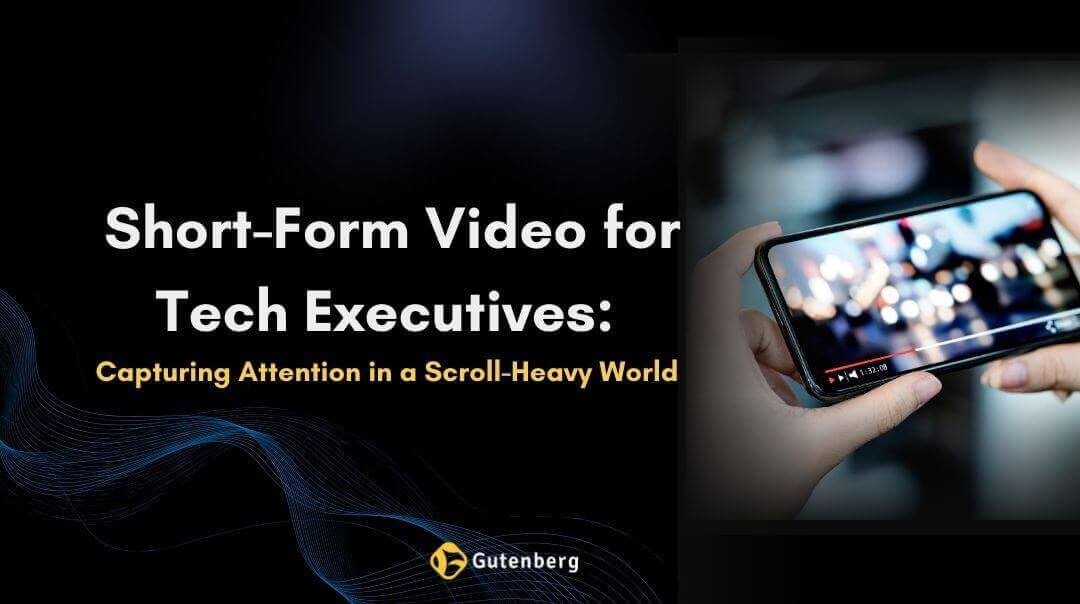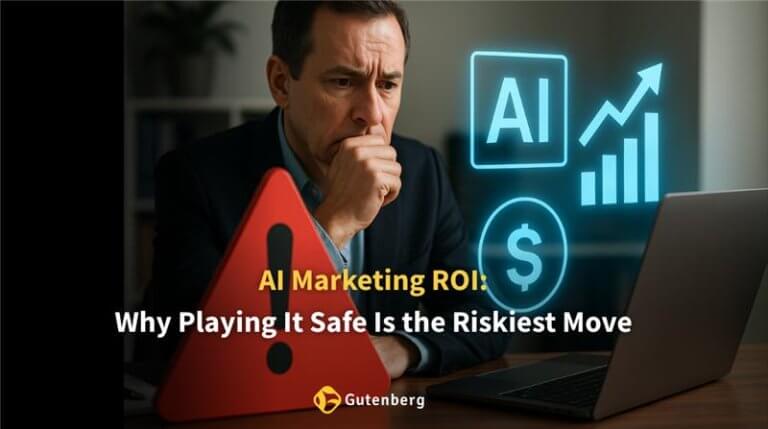In traditional marketing, whitepapers, interviews, and keynote sessions were the go-to formats for tech executives looking to communicate ideas. While these still have their place, they often don’t match how audiences actually consume content today, especially on platforms like LinkedIn, where decision-makers scroll through hundreds of updates each week.
The shift of focus is clear with social media among the audience. Attention spans are shorter, screens are smaller, and executives themselves are also navigating time constraints. In this environment, short-form video for tech executives has emerged as a powerful tool to communicate ideas quickly, clearly, and with more reach.
According to Wistia, short videos under two minutes long had the highest engagement rate at 58%. These numbers reflect a shift not in content quality but in content delivery. What matters is saying more in less time.
In this blog, we’ll explore how short-form video for tech executives is changing how leaders communicate, how B2B video marketing is growing on professional platforms, how tools like AI-powered video creation simplify production, and why a video-first content strategy helps maintain visibility.
Why Short-Form Video Works for Tech Leadership
Video isn’t new to marketing strategies. What has changed is how it’s used by business leaders. Tech executives, once hesitant to appear on camera for quick updates, are now recognizing the impact of concise, high-frequency video content.
Short-form content breaks through digital fatigue and helps leaders deliver consistent messaging without requiring long production cycles or studio-quality setups.
Attention Spans Are Shrinking, But Expectations Aren’t
Audiences today expect clarity without fluff. A study by Vidyard found that 73% of B2B videos are now under two minutes long. This is no accident. It’s a response to how people prefer to engage with information.
For tech executives trying to convey complex thoughts, short-form video for tech executives offers a way to simplify the message while retaining authority. It blends strategic messaging with format flexibility. This is ideal for product commentary, industry insights, or leadership updates.
This trend ties into a broader video-first content strategy where communication starts with short, high-impact video, and then repurposes it into other formats like blogs or carousels.
The Rise of LinkedIn Reels and B2B Adoption
Short-form video is no longer limited to consumer platforms. With LinkedIn testing Reels-style content and encouraging video-first posts, even B2B messaging is being reshaped by snackable formats.
The inclusion of LinkedIn Reels signals a platform-wide shift. It’s no longer enough for executives to just post text-based thought leadership. Video now leads the way.
Short-Form Isn’t Just for Gen Z Anymore
Platforms are adjusting to demand. LinkedIn Reels, still rolling out to more users, signals a clear push toward bite-sized video across professional networks. Reports show that video posts earn 3x more engagement than text-only content on LinkedIn. That makes it an obvious channel for thought leadership and brand positioning.
For tech leaders, using LinkedIn Reels means reaching B2B audiences without relying on long-winded formats. It also supports visual storytelling, which is crucial in showcasing innovation, cultural values, or rapid insights into industry trends.
When supported by consistent branding and presence, short-form video helps tech executives shape executive personas in a format people are more likely to watch and remember.
How Tech Executives Can Use Short-Form Video
The use of video by tech leadership is growing, but success depends on what’s being said and how often. Short-form video enables executives to deliver timely updates, humanize their voice, and address audiences directly.
Whether it’s a CEO speaking to clients or a CTO offering insights, short-form video for tech executives can be purpose-built for a variety of goals.
Use Cases That Build Visibility and Trust
The most effective B2B video marketing doesn’t always sell. It informs, reacts, or explains. Here’s how executives are starting to use short videos strategically:
- Industry commentary: Responding to regulatory changes or market shifts in under a minute
- Product messaging: Introducing a feature or product decision through a quick explainer
- Recruitment support: Highlighting team culture or leadership values
- Investor confidence: Posting quick updates about company milestones or performance
- Speaking highlights: Sharing snippets from conference keynotes or interviews
Each of these formats gives visibility to leadership thinking without requiring audiences to sit through a 10-minute clip.
By integrating this approach into a broader video-first content strategy, tech leaders can increase transparency and approachability. These are two qualities often missing in traditional corporate communication.
AI-Powered Video Creation Makes Execution Easier
Time, not interest, is often the biggest barrier to executive content creation. That’s where AI tools step in. They make video production more efficient without sacrificing quality.
This opens new doors for consistent, agile messaging without pulling leaders away from their day-to-day priorities.
Speed Meets Quality Without Needing a Crew
That’s where AI-powered video creation is changing the game. Tools like Descript, Pictory, and Synthesia allow tech executives or their teams to script, record, edit, and subtitle short videos, often within 20 to 30 minutes.
For tech executives, this means quality content without heavy investment in studio-grade production. It also lowers the barrier for maintaining consistency, which is key to gaining traction.
When AI-powered video creation is paired with clear messaging, executives can maintain a high-quality presence across channels while keeping effort manageable.
How to Build a Video-First Content Strategy
Posting a video occasionally isn’t enough. What moves the needle is a deliberate, consistent video calendar that aligns with business and communication goals.
This is where a strong video-first content strategy can create structure, remove decision fatigue, and turn video into a habit, not a chore.
Consistency Wins Over Perfection
Many executives hesitate to start because they feel each video has to be perfect. But consistency is more important than polish.
A solid video-first content strategy might start with a content calendar featuring:
- Weekly insights: 60-second thoughts on market news
- Monthly updates: Tied to product launches or growth milestones
- Customer response: Regular replies to questions or pain points
The point is to treat video like any other part of the communication toolkit: structured, measured, and planned.
Working closely with internal communications or external agencies like Gutenberg can help maintain alignment with broader brand messaging while taking the operational work off the leadership team’s plate.
Measuring What Matters
Not every video will go viral, and that’s okay. What matters is whether the right people are watching and acting on it.
It’s Not Just About Views
Tracking performance helps refine content, but not all metrics are created equal. Here’s what matters more for short-form video for tech executives:
- Engagement rate: Are people liking, sharing, commenting?
- Watch time: Are they staying past the first 3 seconds?
- Conversions: Is the video leading to speaking requests, follow-ups, or media inquiries?
These insights help determine what’s working and where messaging might need to be sharpened. It also allows companies to track how B2B video marketing is contributing to business outcomes beyond likes and impressions.
How Gutenberg Helps Tech Executives Show Up More Effectively
Leaders have the ideas. Gutenberg helps bring them to screen. Our approach is built for scale, speed, and messaging precision, all without overloading executive bandwidth.
From strategy to execution, we guide tech leadership teams through every step of producing high-impact video content.
Here’s how we support tech leaders through video:
- Script development: Focused on clarity, brevity, and message retention
- AI-assisted editing: To speed up production and reduce bottlenecks
- Channel strategy: Aligned with LinkedIn, YouTube Shorts, and other B2B platforms
- Content planning: Ensures weekly consistency and relevance
Whether you’re a startup founder or a VP at an enterprise firm, our team helps translate your thinking into a content format your audience actually wants to watch.
The best part? We handle the heavy lifting, so you don’t have to.
Learn more at thegutenberg.com
Conclusion: Attention Is Earned in Seconds. Use Them Well
Attention is no longer a luxury. It’s the cost of entry. For executives, communicating with clarity in short bursts isn’t just a trend. It’s a shift in how influence is built.
Short-form video for tech executives delivers what audiences expect: quick insights, real faces, and real-time thinking. It brings leaders closer to their teams, investors, and industry without demanding long production timelines.
When paired with the right video-first content strategy, and backed by tools like AI-powered video creation, video becomes not just a communication channel but a leadership tool.
FAQs
Q1. What kind of topics work best for short-form videos by tech leaders?
Focus on timely insights, market trends, leadership decisions, product updates, or cultural values. Content that explains, responds, or clarifies builds trust and positions executives as accessible and informed.
Q2. Does short-form video actually work for B2B engagement on platforms like LinkedIn?
Yes. Short videos consistently outperform text-only posts in engagement. With LinkedIn leaning into Reels-style content, short-form video gives executives a better chance to connect without relying on long-form production.
Q3. How can tech executives keep up with video creation without losing time?
AI-powered tools help create polished videos faster, from scripting to editing, so leaders can show up consistently without needing a production crew.
Q4. How often should executives post short-form video content?
Start with once a week and stay consistent. A steady rhythm is more valuable than overcommitting. Agencies like Gutenberg help structure these into planned video calendars so content stays aligned with business goals.
Q5. What makes short-form video more effective than traditional formats like blogs or whitepapers?
Short-form video gets to the point faster. In a time-sensitive, mobile-first environment, it delivers clarity, personality, and thought leadership in a format people are more likely to watch and remember.
















